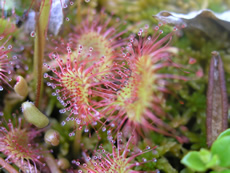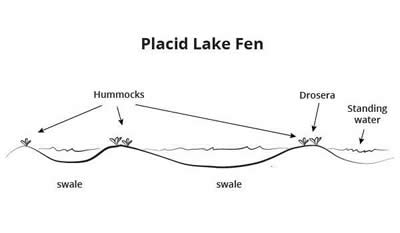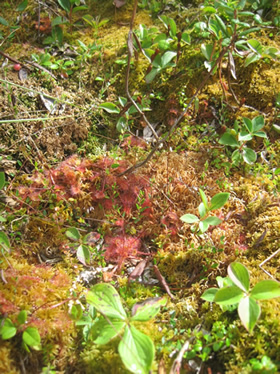Introduction
At its most fundamental level, ecology is an attempt to understand the natural world. We observe “pieces” and notice “patterns”. We then seek to discern the underlying reasons or “processes” that explain these patterns. The pieces could be genes, individuals, populations or species. Patterns include species occurring in one place or time but not another, or behaving differently depending on the environment or populations that vary in their appearance depending on location. Processes could include an organism’s response to the physical environment, competition or predation. The pieces and patterns are the “what”, the processes are the “how” or “why”.
This tutorial will introduce you to the some of the methods and techniques behind constructing testable scientific hypotheses. The following figure provides a schematic representation of the steps required to formulate and test a hypothesis.

Developing a Single Hypothesis
Synthesis: Ecological Theory vs. Observations, The Deductive-Inductive Dialog
When practicing ecology, scientists employ the scientific method: they seek answers to specific questions (predictions derived from scientific hypotheses) about how organisms interact with the physical world and/or other organisms. In developing a hypothesis, an ecologist may take one of two perspectives: either inductive (reasoning from a specific observation to a general relationship) or deductive (the converse, reasoning from a general relationship to a specific observation).
Inductive reasoning is “bottom-up”—you observe an interesting pattern or interaction which you then try to understand more generally. For example, you notice that yogurt left in your refrigerator after its expiry date spoils. You then consider that yogurt is a dairy product and so surmise that all dairy products left in your refrigerator past their expiry dates will spoil. In contrast, deductive reasoning is “top-down”—you start off with the general premise that all dairy products spoil when left in a refrigerator past their expiry dates. Yogurt is a dairy product, so you reach the specific conclusion—yogurt left in my fridge after its expiry date will spoil.
Sometimes ecologists employ a deductive approach, for example, studying how a general process, say competition or predation, influences how organisms interact with one another (predation controls prey abundance, therefore the number of deer in a forest will be determined by the number of wolves). Sometimes, in contrast, ecologists study interesting phenomena (pieces and patterns) that they then try to understand more generally (the number of deer and wolves in a forest appear to fluctuate together, perhaps the number of wolves controls the number of deer). In practise, ecologists routinely use both inductive and deductive techniques. For example, you live in a small town in the mountains and you notice that south-facing slopes (which receive more sunlight) are vegetated mostly with grasses and shrubs, while north-facing slopes are forested. Being a diligent reader of your ecology textbook, you think that this pattern might be explained by the limiting factor of soil moisture—that south-facing slopes receive more solar radiation and are therefore too dry to support trees. You have effectively combined a specific observation (induction) with a theoretical premise (deduction) to your study.
Developing a Single Hypothesis
Pieces
Pieces are the “what” that we observe, be they individuals, members of a population, a species, or members of a functional association, such as seed-eating or insectivorous birds. For the purpose of your field project, the pieces are the organisms or biological attributes that you are going to observe and study. You do not need to identify these organisms to the level of species or any other taxonomic rank, so long as you can meaningfully differentiate them from other organisms. Depending on your familiarity with the plants and animals around you, your study subject could be as specific as open-grown Douglas-fir trees, a particular species of bird or butterfly, or the dandelions in your lawn. Or, it could be as broad as, woody vegetation, or seed-eating birds or raptors. It could also be a single attribute of an individual organism—such as flower width, the feeding time spent in a particular habitat, or the abundance of disease on one part of its body. Pieces can also include properties of groups of organisms, like the number or diversity of species in a community of organisms.
As you think about the subject of your field research project, you need to consider your natural history skill set. You can study anything from the attributes of individual species—the number of flowers on a wild rose shrub—to community-level properties such as species richness and diversity. Larger-scale questions will demand greater taxonomic expertise and you should pick a subject that you feel comfortable measuring in the field.
Examples of taxonomies or classifications that you could use (each link will open in a new tab or window):
Developing a Single Hypothesis
Patterns
Patterns are the arrangement of organisms or biological attributes in time and space. The world is replete with patterns, and much of the science of ecology is dedicated to describing and understanding them. Patterns can be at vast spatial or temporal scales—the increase in biological diversity from the poles to the equator or biogeographical changes related to glaciations—to minute.
For the purpose of your research project, the patterns that you observe are likely to be more small-scale and immediate. You might find that a certain kind of plant only occurs next to wetlands where the soil is moist, not in the wetland where the soil is saturated or in the uplands where the soil is dry. Or perhaps a shrub occurs—you think—at greater abundance in a forest where there are gaps in the canopy. Maybe you believe there are more kinds of birds in one field than another. If you are unfamiliar with ecology, it may be easier to identify a pattern within a given species such as the amount of time a particular bird species spends foraging on the ground versus on tree branches, or the variety of insect pollinators that come to one flower species growing in the shade as compared to same species growing in the sun. These are all patterns that avail themselves to study.
Developing a Single Hypothesis
Process
Processes are the “how” or “why” of the patterns we observe; the underlying factors that determine what species occurs where and in what time. They are the great theoretical constructs of ecology: energy flow, limiting factors, competition, predation, mutualism, etc. Much of this course will involve delving into these ideas to greater depth.
Developing a Single Hypothesis
Hypothesis
A scientific hypothesis is a testable formulation of a cause and effect relationship. You observe an effect (a pattern) to which you propose a cause (an underlying process). In effect, you make an educated guess. A scientific hypothesis must be falsifiable—that is, the collection of additional information must lead either to the acceptance or rejection of the hypothesis.
Consider the example of two fields that appear to be very similar in terms of habitat. Both are open grassy areas with patches of shrubs. However, after observing each field for some time, you conclude that one supports a much greater diversity of bird species than the other. To discover why, you can formulate a hypothesis and test it. You could hypothesize local habitat quality controls bird diversity—for example, the habitat with greater food resources will support the greater diversity of birds. This hypothesis can be tested. You can characterize the two fields in relation to their assumed quality as bird habitat and determine whether the field with better habitat does, in fact, support greater bird diversity.
Hypotheses usually concern the underlying processes that might explain the patterns that we observe. However, for the purpose of your research project, you can also make a confirmatory hypothesis to test whether your observed pattern is strong enough to be significant. Humans have an innate predisposition to perceiving patterns. Sometimes what we think is a meaningful pattern, is really within the bounds of normal variability that we would expect do to chance alone.
Developing a Single Hypothesis
Prediction
Predictions are derived from hypotheses. The prediction is what we test to determine whether the hypothesis is true or false. Following the bird example, if your hypothesis is that habitat quality influences bird diversity, your specific prediction could be that the field with the greater habitat quality will support the greater diversity of bird species. It seems simple, but the devil is in the details. Habitat quality includes a lot of specific components. For a prediction to be meaningful, it should be precise. This could be accomplished by either rigorously defining habitat quality (perhaps you found a pre-existing method in the scientific literature) or by measuring a specific component of habitat quality instead (food sources, cover, structural diversity, etc.). Making predictions as specific as possible, will help you to think critically about your hypotheses and make your assessment of them less ambiguous.
Developing a Single Hypothesis
Statistical vs. scientific hypotheses: null hypotheses
Scientific hypotheses are educated guesses about why an ecological phenomenon is or has occurred. In contrast, a null hypothesis is a statistical technique used to test the validity of the scientific hypothesis. If the scientific hypothesis is that black-footed ferrets control prairie dog populations, then the null hypothesis (which is the converse of the hypothesis and is equivalent to a prediction) would be that there is no relationship between the presence of black-footed ferrets and the numbers of prairie dogs. This information is often presented in the Results section of research papers with a statement like, “There was no significant difference in number of prairie dogs in areas with or without black-footed ferrets, (p=0.25).” In this hypothetical example, the “p-value” indicates the probability that the results the researchers obtained would be found by chance alone. Typically, if p-values obtained through statistical tests are less than 0.05, (i.e., that there is less than a 5% probability that the results could have resulted from chance alone) researchers consider this enough evidence to reject the null hypothesis (or that prairie dog numbers don’t fluctuate with presence or abundance of black-footed ferrets). By rejecting the statistical null hypothesis, researchers provide support for their scientific hypothesis. However, it is important to note that in some instances, a scientific hypothesis may stipulate that there would be no observed difference in population numbers. Hypothetically, this might happen if you thought that the most important factor structuring prairie dog populations was not their predators, but their behavior, and that prairie dogs would migrate so as to avoid overcrowding. In this case, your null hypothesis would be that there would be no difference in prairie dog population density. P-values greater than 0.05 would give you no evidence to reject your statistical null hypothesis, which in turn, would provide support for your scientific hypothesis.
The vast majority of scientific hypotheses predict on “differences between” or “associations between one variable and another”. It is much rarer to read scientific hypotheses which predict “no difference”, but it is important for your understanding of the peer-reviewed literature, to realize the difference between scientific and statistical hypothesis.
Developing Multiple Hypothesis
Often there are multiple plausible explanations for an observed pattern. If you observe a species occurring in one place but not another, it may be because of differences in the physical environment, the effects of competition with another species, or the vagaries of past colonization. Some, all, or none, of these factors may be important in explaining the observed pattern. More formally, proposing multiple hypotheses is part of the hypothetico-deductive method.
Returning again to bird-field example, suppose that in addition to your hypothesis, that local habitat quality influences bird diversity, you also hypothesized that bird diversity is influenced by landscape context. That birds, being highly mobile, are influenced by the structure of the surrounding landscape, and that landscapes with a greater diversity of habitats will support more species of birds. You could then test both hypotheses concurrently.

Developing Hypotheses: An Example
Pieces
You are walking around a wetland that fringes Placid Lake in Wells Grey Provincial Park, British Columbia. This wetland is a poor fen that has an undulating surface made up of mossy mounds that rise above the wetland surface and low swales with standing water. You notice a carnivorous plant, roundleaf sundew (Drosera rotundifolia), is common in the fen. These unique plants have sticky glands on their leaves which are used to trap small insects. Sundews digest the insects with enzymes released from the glands. This plant carnivory is an adaptation to compensate for the low levels of nitrogen typically found in these habitats. Click on each image to view it full-size.
 |
 |
 |
Pattern
 |

|
Developing Hypotheses: An Example
Process
Based on your observations and the concept of limiting physical factors, you think that level of water saturation in the substrate may be limiting the sundews to the moist, but not saturated, tops of the mounds.
Hypothesis
The distribution of roundleaf sundew at Placid Lake is determined by substrate moisture.
Predictions
You make two predictions from your hypothesis. The first, to empirically validate the pattern that you observed, is that roundleaf sundew occurrence is limited to mound tops. The second is that roundleaf sundew abundance diminishes as substrate moisture increases.